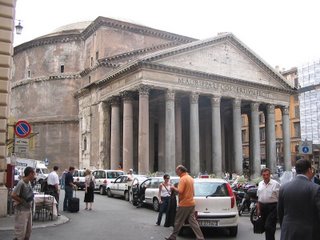The Pantheon. Rome, Italy. Roman concrete, circa 125 AD.

So! Where was I? The Parthenon. Whatever. I'm done with the Parthenon. The whole Acropolis. You want to know more, go look it up. Today I'm going to talk about the Pantheon, because that's what I feel like doing, and you need to know the difference.
Now if we break "Pantheon" down into its Greek roots, like all cool kids do, we get pan, which basically means "all," and theos, which means "God," or "of the gods." Most Roman and Greek temples were dedicated to only one god, or in some cases two - but the Pantheon is unique in that it seems to be dedicated to all of the gods. You could say that Rome's Pantheon is dedicated to the entire Roman pantheon, if it didn't sound so stupid when you said it.
If you enlarge the photo I've posted here, you can pretty clearly make out the inscription above the Pantheon's portico. It's Latin, and says, "M.AGRIPPA.L.F.COS.TERTIUM.FECIT." This roughly translates to, "This was built by M [Marcus] Agrippa, the son of L [Lucius], during his third consulate." Marcus Agrippa was the son-in-law of the famous Roman emperor Augustus. (Augustus created the Roman empire after his pal Julius Caesar was killed - for more of this story, look at my entry from March 15.) Contrary to what common sense would tell us, the Pantheon wasn't really built by Agrippa. It was actually built by Emperor Hadrian, some 150 years later. Ready for the explanation? Here goes.
The conclusion most scholars come to now is that our Pantheon is not the first temple to be built on this site. The first Pantheon was built around 25 BC, by Agrippa, and was a pretty normal, rectangular Roman temple. This original building, however, was destroyed in a fire, probably around 60 or 70 AD. Well Emperor Domitian rebuilt the Pantheon a few years later, but then, guess what? Pantheon II was destroyed in a fire, too. So finally Hadrian came along and built what I will officially dub Pantheon III, the Pantheon that still exists today.
We're really not sure why Hadrian put Agrippa's name on the building instead of his own. It could be that he wanted people to associate his name with Agrippa's, a move which would have made his claim to the throne a little more legitimate in the eyes of his citizens. Or it could be because he screwed up.
Don't get me wrong, the construction of the Pantheon is amazing, which is why it is so famous today. The dome is so perfect that a giant ball could fit inside the building exactly. It was also the largest dome in the world for over 1000 years. The Romans were able to build it by using concrete of varying weights - weightier concrete, made from heavy stone like travertine, was used at the base of the building, while concrete with lighter stone like pumice was used for the top. Those Romans were smart folks.
However, the Pantheon is obviously screwed up. Take another look at the picture I posted here. I posted this one because, above the portico, you can make out two triangles - the one at the front is pretty obvious, but you can see the corner of a second peeking out. These triangles are called pediments. Now there should really only be one pediment - those two pediments should line up with each other, so that the second fits perfectly behind the first and can't be seen at all. And while you're at it, take a look at the two cornices that surround the building. (By cornices, I mean the funny looking horizontal lines that stick out from the sides.) The higher of the two cornices is aligned with the hidden pediment, not the obvious one, so if you look at the Parthenon from the ground, the lines don't seem to match up at all. The problem, you see, is that the columns in the portico are all ten feet too short.
See, these columns are monolithic, which means that each one is carved from a single chunk of granite. Back in the day, you could only get monolithic granite columns from Egypt, and they were made in three different heights: 50 feet, 40 feet, and, ummm... dang, I forget the size of the third. I do remember that it is shorter than 40. We'll say 30 for good measure. Well, while the Pantheon was being built, Hadrian was also building a monument to Trajan, his predecessor. The Pantheon's portico was supposed to be built using columns of the 50 foot variety, but so many 50 foot columns were needed for the Temple of Trajan that there just weren't any left. Most of the Pantheon had already been finished by the time anyone realized this, so re-designing the building wasn't really an option. Hadrian probably could have waited a year or so for some more columns of the right size to arrive from Egypt, but he decided to finish the building with the shorter columns that were available at the time. What's really sad about all this is that the Temple of Trajan was destroyed quite some time ago by an earthquake. Bummer.
But the Pantheon really does rock, and there are many other intersting features I could point out, like its oculus, coffered ceiling or syncopated interior. However, talking about all of these would take too long. So if that stuff sounds interesting to you, go look it up yourself.




0 Comments:
Post a Comment
<< Home